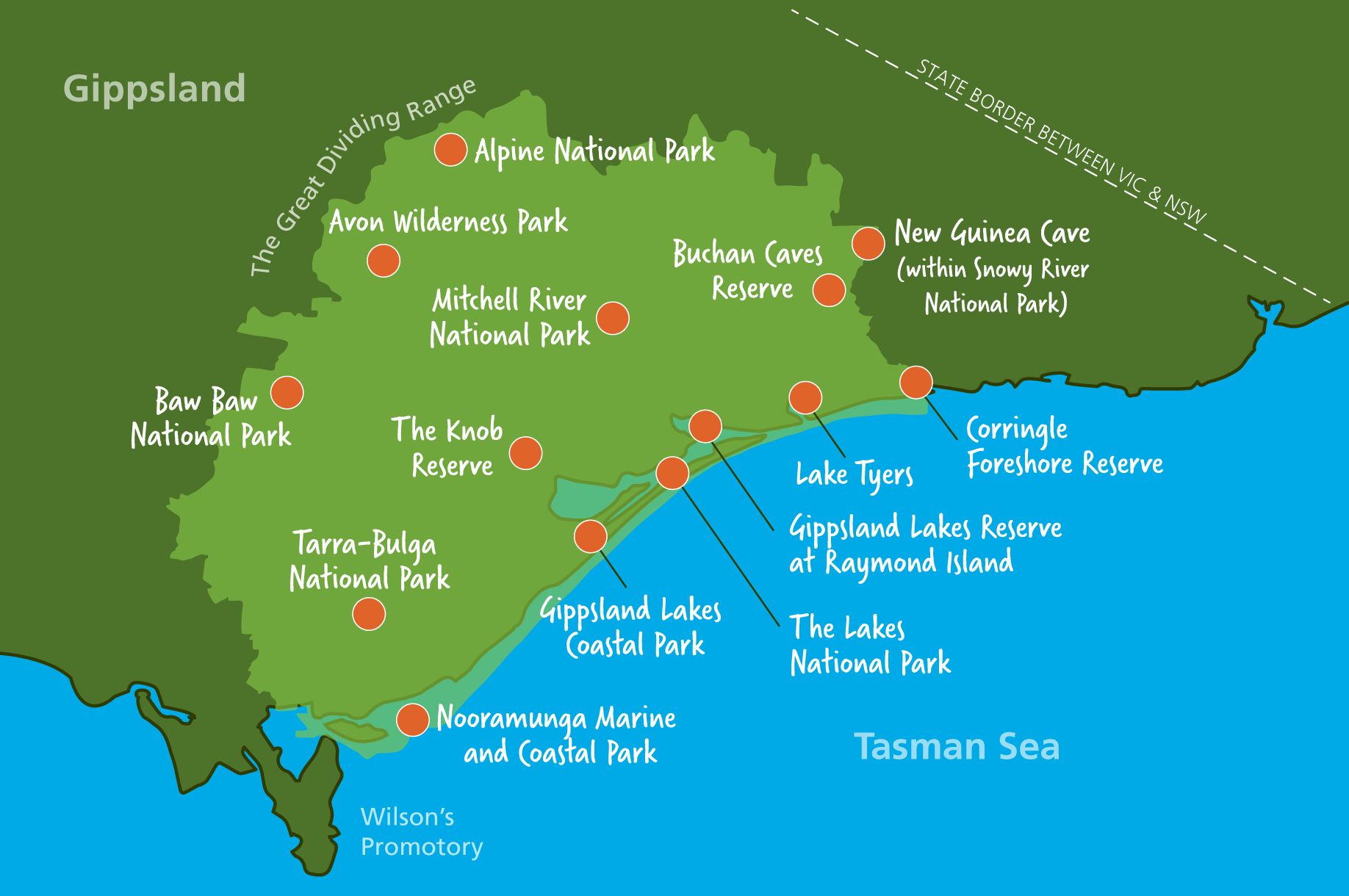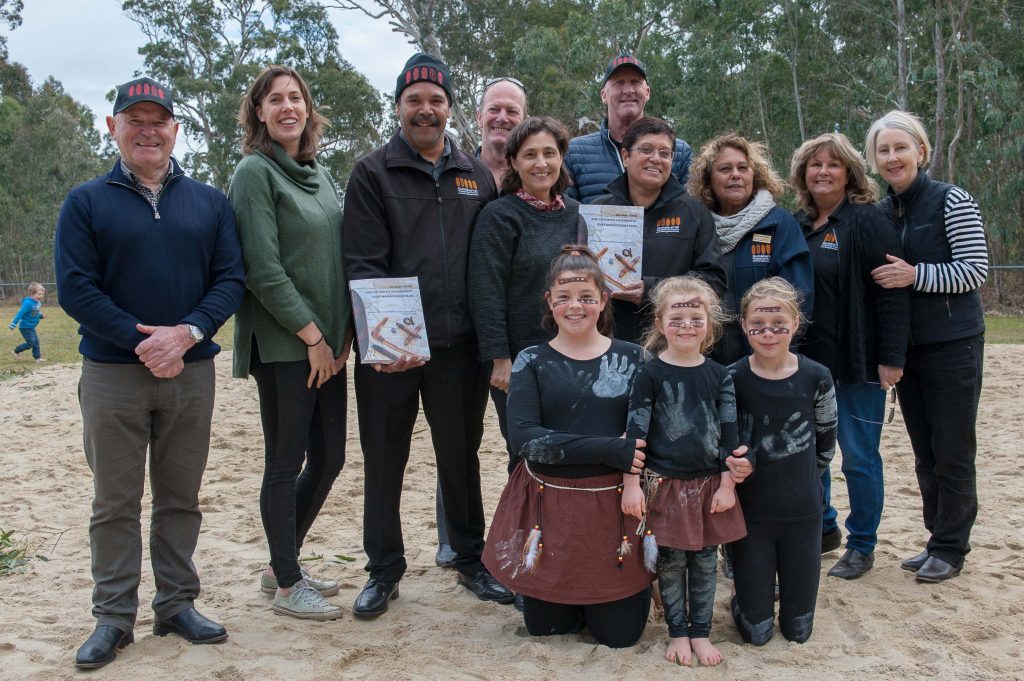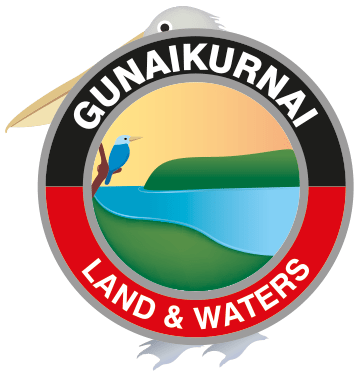Joint Management
The Gunaikurnai people’s strong and continuing connection with Country was legally recognised in October 2010. As part of the package of agreements in the Traditional Owner Recognition and Settlement Agreement, Gunaikurnai hold Aboriginal Title over 14 national parks and reserves.
-Gunaikurnai Traditional Owner Land Management Board
Aboriginal Title is the grant of crown land to Traditional Owners for the sole purpose of joint management, and recognises Aboriginal peoples’ deep understanding of land, water and biodiversity.
Joint management of this land is a partnership between Gunaikurnai Traditional Owners and the State, allowing both to bring their knowledge and skills to the management of protected areas.
These environments including the forest, rivers, beaches, plants and animals are all part of Country and the cultural identity of the Gunaikurnai.
They are valued for the environment and as a vital part of contemporary Aboriginal culture. Protecting, managing and enjoying the land is an important part of this connection and responsibility.
Joint Managed Country
Country is vital to contemporary Aboriginal culture and an important part of the cultural identity of Gunaikurnai Traditional Owners.
Joint management is a new way of managing the land, and an exciting opportunity for us to have real influence over what happens on our Country.
As part of the model, Gunaikurnai and Parks Victoria Rangers are collectively responsible for the on-ground management of the 14 parks and reserves.
The partnership also brings the opportunity for knowledge sharing and development of employment, education and training. With the partnership comes decisions, resources, skills and equal opportunity in all relationships and business.
This is the basis of the partnership between the Gunaikurnai and the Victorian Government.

How Joint Management works on Gunaikurnai Country
The joint management is overseen by the Gunaikurnai Traditional Owner Land Management Board (GKTOLMB) comprised of a majority of our Traditional Owners, along with representatives of the broader community.
The long-term aspiration of the Gunaikurnai, as shared by the GKTOLMB, is to progress through joint management to full management of all Aboriginal Title land, generating a range of cultural and economic benefits for Traditional Owners and delivering important outcomes for the broader community.
It is recognised that there is a long way to go before this aspiration can be fully realised, with steps being taken now to build the capacity, experience and evidence base to work towards a full transfer of responsibility to Gunaikurnai in the future.
This joint management model is a new way of managing the land, and an exciting opportunity for us to have real influence over what happens on our Country.

The objective of joint management is to establish an equitable partnership between the State and the Gunaikurnai People to ensure innovation and excellence in joint management, including the following purposes:
- benefitting the Gunaikurnai People by recognising, valuing, promoting and incorporating their culture, knowledge, skills and decision-making processes;
- benefitting the community needs of all Victorians and visitors for public education and enjoyment through quality experiences, services and information;
- conserving, protecting and enhancing natural and cultural values;
- enjoying widespread community support; and
- ensuring the well-being of country and the wellbeing of people.
The Gunaikurnai native title settlement package of 2010 included a consent determination and Indigenous Land Use Agreement. In addition there were a number of agreements under the Traditional Owner Settlement Act 2010 and Conservation Forests and Lands Act 1987 which includes a Recognition and Settlement Agreement (RSA), a Land Agreement and a Traditional Owner Land Management Agreement.
The below provides a summary of what each agreement does:
- The consent determination and the RSA of October 2010 recognises the Gunaikurnai peoples’ connection with the land.
- The Land Agreement (which is part of the RSA) is the agreement through which Aboriginal Title is granted.
- The TOLMA (which sits under the Land Agreement and RSA) sets out the commitment and parameters for establishing a Traditional Owner Land Management Board.
TOS Act & Aboriginal Title
Section 23 of the TOS Act specifies that before Aboriginal Title is granted a TOLMA must be agreed under s82P CFL Act. The TOLMA records the commitment to establish the Traditional Owner Land Management Board and appoint its members. Aboriginal Title will be granted over the 10 areas of land subject to the TOLMA.
What is the Victorian Traditional Owner Settlement Act?
The Traditional Owner Settlement Act 2010 is a Victorian law which provides for an out-of-court settlement of native title and resolution of land justice.
The Act allows the Victorian Government to make agreements with Traditional Owners to recognise their relationship to land, and provide for certain rights on Crown land and other benefits. In return for entering into a settlement Traditional Owners must agree to withdraw any native title claim they have pursuant to the Commonwealth Native Title Act 1993, and to not make a claim in the future.
Traditional Owner groups may still pursue a formal determination of native title under the Native Title Act 1993, through the Federal Court process if they wish.
Agreement between the State and the Gunaikurnai
On 22 October 2010 the Federal Court recognised that the Gunaikurnai holds native title over much of Gippsland.
On the same day, the State entered into an agreement with the Gunaikurnai (Recognition and Settlement Agreement) under the Traditional Owner Settlement Act 2010. The Agreement between the State and the Gunaikurnai is the first under the Traditional Owner Settlement Act 2010.
The Agreement area extends from west Gippsland near Warragul, east to the Snowy River and north to the Great Dividing Range. It also includes 200m of sea country offshore. The determination of native title under the Native Title Act 1993 covers the same area.
Native title is taken to be extinguished on grants of freehold land (private land) and by crown land subject to public works (roads, public development etc). Therefore the agreement and the native title determination only affect undeveloped Crown land within the Gippsland region.
What does the agreement include?
- Transfer of 10 the parks and reserves listed below to the Gunaikurnai as ‘Aboriginal Title’ to be jointly managed by the Gunaikurnai and the State.
- Rights for Gunaikurnai people to access and use Crown land for traditional purposes, including hunting, fishing, camping and gathering in accordance with existing laws.
- Funding for the Gunaikurnai to invest in economic development and cultural strengthening opportunities and to meet their obligations under the settlement
The 10 Parks and Reserves
- The Knob Reserve, Stratford
- New Guinea Cave (within Snowy River National Park)
- Tarra Bulga National Park
- Lake Tyers Catchment Area
- Mitchell River National Park
- Buchan Caves Reserve
- Lakes National Park
- Gippsland Lakes Reserve at Raymond Island
- Gippsland Lakes Coastal Park
- Corringle Foreshore Reserve
What changes will there be to National Parks and Reserves?
All land subject to Aboriginal Title will continue to be managed consistent with the applicable public land legislation. Existing access and use rights (including existing licences, leases or permits on Crown land) will not be affected.
A Traditional Owner Land Management Board (TOLMB) will be established including Gunaikurnai and other representatives. The Board will manage all the jointly managed parks and reserves within the agreement area. The Board will develop a Management Plan with the Department of Environment and Primary Industries that will set the strategic direction for the land. A Management Plan will be subject to public consultation and final approval from the Minister for Environment and Climate Change. It must also be consistent with legislation and policies applicable to that public land reservation.
Other Key Legislation
- Traditional Owner Settlement Act 2010
- National Parks Act 1975
- Crown Land (Reserves) act 1978
- Forests Act 1958
- Public Administration Act 2004 (Vic)
- Conservation, Forests and Land Act 1987
A Joint Management Plan must provide for the sustainable management of the Appointed Land and may include strategies for:
- The conservation of natural values and cultural values (including heritage protection);
- Managing threatened species;
- The recognition and utilisation of traditional Gunaikurnai knowledge and customs;
- Attracting and managing visitors;
- Managing authorised and adjacent uses (including third party interests);
- Community awareness and involvement;
- Managing public use and access to the land;
- Plan implementation;
- Providing operational support to the Board of Management;
- Promoting, encouraging and assisting Gunaikurnai persons to take advantage of employment, training and contracting opportunities relating to the land;
- Managing commercial activities;
- Managing fire consistently with the Secretary’s directions;
- Any additional matters contained in relevant Ministerial guidelines / Joint Land Management Principles.
Joint management will benefit both Gunaikurnai and the wider community through recognising Indigenous culture and knowledge, providing quality tourism experiences, improved public education and by conserving, protecting and enhancing natural and cultural values. There will be increased funding to support joint management and to employ Gunaikurnai people to work on country. This will result in healthier parks and better visitor experiences.
Directed by the JMP, the intention is to enable the practice of traditional land management together with the State’s contemporary natural resource management systems.
What’s new in JM?
Each year, the GKTOLMB host a Joint Management Reflections Workshop involving all partners involved in joint management.
The feedback provided is a very important way for us to know where Joint Management is delivering for Gunaikurnai people, and what the improvement opportunities are.
We invite you to click below to read a summary of feedback from 2022.
Take a look at why Joint Management is so important to our mob
Watermark Artwork
The Wrens are important totems for the Gunaikurnai people. In traditional times (i.e. pre- European) the Gunaikurnai belief system was that males were born and took the Yeerung (emu wren) as their totem animal, and females were born with the Djeetgun (superb blue wren) as their totem.
All men are Yeerung and all females are Djeetgun and are never to injure these animals for they are brothers and sisters of the Gunaikurnai.
The wren artwork has been used as inspiration for the design and development of JM branding.






